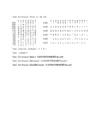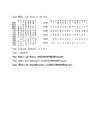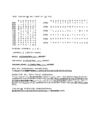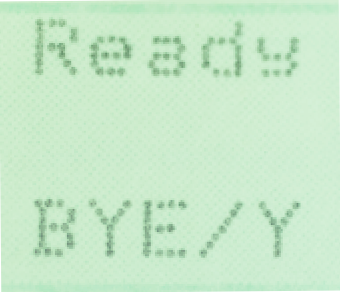Retro Type 3 PostScript Fonts
This page contains some retro fonts from classic dot-matrix printers in Type 3 PostScript form. PostScript fonts are fonts written in the PostScript language, designed to integrate with PostScript's font rendering engine. They can be embedded in PostScript files. Type 3 PostScript fonts are the original end user font format. Type 1 fonts follow Adobe's binary string font format (which Adobe kept proprietary initially). Other types exist, but those have been the most common for covering ranges of 256 glyphs or less.
The normal size for the fonts on this web page is 12 pt, which prints at the traditional line spacing of six lines per inch. Each font on this web page has four variants: normal, Bold, Oblique, and BoldOblique. The Bold versions simulate darker appearance with wider "dots", as may have resulted from repeated overprinting of the same character on a device using a printer ribbon. The Oblique forms are skewed at a 12° angle from the vertical, which is the convention with oblique forms of PostScript fonts. The Oblique and BoldOblique forms would not have been possible on the legacy hardware these fonts model; they are included for additional effects and experimentation.
In addition to the normal character range for each font, they
also contain glyphs for IBM card punch character set support
and to support the deckmate program on this website
(in octal and hexadecimal):
| \242, 0xA2 cents | \263, 0xB3 double dagger | |
| \262, 0xB2 dagger | \330, 0xD8 logical not |
The cents, dagger, and double dagger code points are the standard PostScript font locations for those glyphs in Times-Roman, Helvetica, and other PostScript fonts. The logical not code point is the location of that glyph in the PostScript Symbol font.
Why PostScript?
Why indeed. Why not some "modern", compact, "much better" binary font format? Well, Type 3 PostScript fonts are PostScript programs written in plain ASCII. Thus these fonts are much easier for someone interested to study directly, learn from, and adapt if desired — I am not aware of any other complete Type 3 PostScript font example anywhere on the Web. Plus I already had created such PostScript fonts stretching back decades that I could dust off to help preserve some of that work. Also, being plain 7-bit ASCII, this font format should have long-term archival permanence for simulating classic printing outputs from a bygone era compared to the ever-changing nature of binary font formats.
How to Use These Fonts
These are PostScript fonts that can be embedded in a PostScript
document, Encapsulated PostScript (EPS) file, etc. The font
definitions only use PostScript Language Level 1 and are
seven-bit clean to maximize their portability. (Note for
PostScript experts: the font files use the PostScript
setcachedevice operator and provide the original
BuildChar procedure as well as the newer
BuildGlyph procedure; BuildChar
is written to invoke BuildGlyph.)
For best integration, use these fonts in a PostScript file using
Adobe's Document Structuring Conventions (DSC) version 2.1 or later.
Font files should appear in the file header between a
%%BeginSetup…%%EndSetup
line pair, which should follow the %%EndProlog
line. Here is a short example:
%!PS-Adobe-2.1
%%Pages: 1
%%DocumentFonts: DOTwriter DOTwriter-Bold
%%DocumentSuppliedFonts: DOTwriter DOTwriter-Bold
%%EndComments
%%EndProlog
%%BeginSetup
[insert PostScript font file "DOTwriter-1.2.ps" here]
%%EndSetup
%%Page: 1 1
/DOTwriter findfont 12 scalefont setfont
72 688 moveto (Test of DOTwriter font at 12 pt.) show
/DOTwriter-Bold findfont 12 scalefont setfont
72 676 moveto (Test of DOTwriter-Bold font at 12 pt.) show
showpage
%%Trailer
%%EOF
You can convert the resulting PostScript file to PDF with
ps2pdf or a similar utility. All of the PDF
files on this page were created using ps2pdf.
Here is the result of converting the above PostScript:
sample.pdf (40 kB).
Cardpunch

|
The Cardpunch font simulates the dot-matrix printhead of a card punch machine, which would print glyphs along the top of a card corresponding to the card punch code for each column. Punched cards only printed upper-case letters, so some artistic license was taken to add lower-case letter forms. This font renders square dots in a 5 column by 7 row square grid. Four variant fonts are available: Cardpunch, Cardpunch-Bold, Cardpunch-Oblique, and Cardpunch-BoldOblique.
|
DOTwriter

|
The DOTwriter font simulates the dot-matrix printhead of a Digital Equipment Corporation (DEC) LA36 DECwriter. I created this ASCII font from LA36 printouts of mine. The DECwriter printed round dots in a 7-by-7 grid, but with horizontal dot spacing tighter than vertical dot spacing. The print head consisted of a vertical column of seven heads driven by servos that could only strike impressions in every other column, giving them time to retract fully after striking. This constraint gave the DECwriter glyphs a somewhat unique look. Four variant fonts are available: DOTwriter, DOTwriter-Bold, DOTwriter-Oblique, and DOTwriter-BoldOblique.
|
DOTwriterAPL — an ISO-IR-68 APL Font

|
The DOTwriterAPL font simulates the dot-matrix printhead of a Digital Equipment Corporation (DEC) LA36 DECwriter with the optional APL character ROM. This LA36 with the APL character set option was also called the LA37. The font renders glyphs according to the ISO-IR-68 standard from the APL Working Group of the Canadian Standards Association, "APL Character Set for Workspace Interchange", 1 June 1983. DEC used this standardized encoding on DEC APL for their TOPS-10 and TOPS-20 systems. You can download a copy of that document here: ISO-IR-68.pdf (672 kB). The August 1979 manual for DEC APL can be downloaded here: APLSF_Language_Manual.pdf (69 MB). DOTwriterAPL is the only font family on this web page that defines a glyph for the ".notdef" PostScript character encoding. The glyph is rendered as the APL "squish quad" symbol, which is a narrower form of the APL "quad" symbol. Special thanks to the Computer History Museum of Mountain View, California, USA for providing me with a scan from a 1985 DEC newsletter showing a DECwriter APL test printout from the APL Special Interest Group (SIG). The overstruck characters in that scan allowed me to verify vertical alignment of all APL glyphs. That along with a copy of the entire DECwriter ISO-IR-68 range in my hard-copy LA36 manual allowed me to adapt the existing DOTwriter font family quickly to create the DOTwriterAPL family. You can see an excerpt from the newsletter here: DECwriter-APL-Test-Print.pdf (280 kB).
Four variant fonts are available: DOTwriterAPL, DOTwriterAPL-Bold, DOTwriterAPL-Oblique, and DOTwriterAPL-BoldOblique.
|
Exploring PostScript
PostScript is a very powerful, expressive, and efficient graphics description
language. I have been using it since writing software for an Apple LaserWriter
in 1986 (the first of many). Today PostScript is usually converted into Adobe's
PDF file format with programs such as ps2pdf and ghostscript
but you can still create your own PostScript programs and then convert them to PDF
for display and printing.
The language is very enjoyable when you get used to its postfix command paradigm. If you want to learn more (even if only to better understand what the font files on this page are doing), here are some recommendations.
First, start with Adobe's "Blue" and "Red" books. Then to get a deeper understanding of the inner workings of the PostScript engine, study Adobe's "Green" book. Adobe has many of their documents available as free PDF downloads now, but it is easier learning the language if you have at least the physical Blue and Red books. Here is a synopsis of this triumvirate of books, followed by a few others.
-
"Blue Book": Adobe Systems, Inc.,
PostScript Language Tutorial and Cookbook,
Adobe Systems, Inc. Addison Wesley, 1985. ISBN 0-201-10179-3.
Start with this book. It has loads of examples you can work through, building up in complexity as the book progresses. Make sure to begin each of your PostScript files with the line "%!" (without the quotes); most of the examples do not do that. The cookbook part even has a chapter on Type 3 PostScript fonts. With all that has been written on PostScript, in my opinion nothing has surpassed the clarity and scope of this book for a first-time PostScript programmer. -
"Red Book": Adobe Systems, Inc.,
PostScript Language Reference Manual,
Adobe Systems, Inc. Addison Wesley, 1985, ISBN 0-201-10174-2.
Get this book at the same time as the Blue Book if you can and keep it nearby while reading through examples in the Blue Book. You can do without it if you must, but it will help. It too has a chapter on PostScript Type 3 fonts. This book also covers version 1.0 of Adobe's Document Structuring Conventions (DSC). Those are comments beginning with "%%" that provide information to rendering devices about the structure of a PostScript document. -
"Green Book": Adobe Systems, Inc.,
PostScript Language Program Design,
Adobe Systems, Inc. Addison Wesley, 1988. ISBN 0-201-14396-8.
This book provides an in-depth understanding of the PostScript engine. Read it after you have worked your way through examples in the Blue Book that interest you and you want a deeper understanding of how PostScript files are executed and graphics are rendered. It also covers version 2.0 of Adobe's DSC, which among other additions introduces the "%%BeginSetup" / "%%EndSetup" and "%%BeginFont" / "%%EndFont" DSC comments that are shown in the example at the beginning of this web page. Glenn Reid wrote this book. He went on to write another book with examples containing version 2.1 DSC comments: Thinking in PostScript, Addison Wesley: 1990. ISBN 0-201-52372-8. -
"Black Book": Adobe Systems, Inc.,
Adobe Type 1 Font Format,
Adobe Systems, Inc., March 1990. Part Number LPS0064.
This book covers the binary strings, private area, and all other aspects that comprise a PostScript Type 1 font. -
Adobe Systems, Inc., PostScript Language Reference Manual, Second Edition.
Addison Wesley, 1990. ISBN 0-201-1812704.
This book is available free for download from Adobe, but it is huge and so is not the best place to start learning PostScript. The physical book is as thick as the Red, Green, and Blue books combined! It does introduce Level 2 PostScript commands (some of which apply to font rendering), and covers DSC 3.0 comments. Read this if you desire to dive deeper into PostScript after you have read the Blue and Red books.
License
The Cardpunch, DOTwriter, and DOTwriterAPL font files on this web page are Copyright © 2020 Paul Hardy and are distributed under the SIL Open Font License version 1.1 (http://scripts.sil.org/OFL). For reference, download the files OFL.txt and OFL-FAQ.txt.
PostScript® is a registered trademark of Adobe Systems, Inc.

